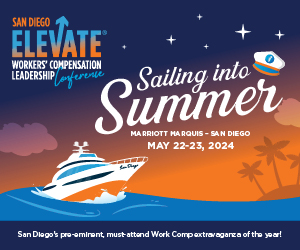Industry Insights
March 1, 2017
Wickert: Questionable Court Decision Creates Interesting Subrogation Opportunities
- State: Hawaii
- - 0 shares
If a contest were held for the worst appellate decision of 2017, we might already have a winner.

Gary L. Wickert
The recent, unpublished Hawaii Court of Appeals decision in Hawaiian Dredging Constr. Co. Inc. v. Fujikawa Assocs. Inc., 2017 WL 663540 (Haw. App. 2017) turns the very concept of workers’ compensation in the Aloha State upside down, and could result in higher construction costs as general liability carriers realize that indemnity clauses could cost their insured much more than previously thought. At the same time, the decision provides some interesting reimbursement opportunities in Hawaii construction projects, which are unavailable in any other state.
In Hawaiian Dredging Constr. Co. Inc. v. Fujikawa Assocs. Inc., Hawaiian Dredging Construction Co. (HDCC) was the contractor, and Fujikawa was the subcontractor. In the contract, Fujikawa indemnified HDCC, as follows:
Subcontractor shall indemnify, and save harmless contractor and owner, and their agents and employees, from and against all liabilities on account of: … (D) any and all damage or injury to person or property arising directly or indirectly from the performance of the work and/or the operations of subcontractor to the extent any such damage or injury is attributable in whole or in part to the acts or omissions of subcontractor, anyone directly or indirectly employed by subcontractor or anyone for whose acts subcontractor may be liable.
One of HDCC’s employees, Gabriel Balon, was injured by a piece of air duct being installed by Fujikawa. HDCC began paying workers’ compensation benefits to Balon and demanded indemnity from Fujikawa for reimbursement of the paid benefits. HDCC filed suit, and Fujikawa argued that HDCC should not be allowed to pass on its workers’ compensation liability to Fujikawa.
The circuit court ruled in favor of Fujikawa. Looking at the contract as a whole, it held that there was no clear assumption of workers’ compensation liability, which is a cost of HDCC doing business rather than “damage or injury” for which Fujikawa owed indemnity. It felt that to assume the cost of expense of HDCC doing business in paying workers’ compensation benefits for a work-related injury was too far a stretch.
The Court of Appeals reversed and held for HDCC, concluding that Fujikawa clearly agreed to indemnify HDCC against all costs and expenses arising from injury to persons because of Fujikawa’s work. HDCC accepted Balon’s workers’ compensation claim, and Balon received workers’ compensation benefits. Thus, HDCC incurred expenses in paying benefits under the workers’ compensation law.
HDCC’s claim for indemnity is based on “an independent duty” created by the indemnification provision in the subcontract. The subcontract required indemnification to HDCC for costs or expenses, including workers’ compensation benefits paid to Balon that resulted from Fujikawa’s acts or omissions. HDCC alleged, but didn’t provide summary judgment evidence, that Balon’s injuries were caused by Fujikawa’s acts.
For this reason, it held that the trial court was correct in not granting HDCC’s motion for summary judgment. Nonetheless, the Court of Appeals agreed that the circuit court erred when it granted Fujikawa’s cross-motion based on its conclusion that indemnification for expenses stemming from workers’ compensation benefits is not within the scope of the subcontract’s indemnity clause.
While there was a lot of discussion in the case about the “Clear and Unequivocal Assumption of Liability Standard” on appeal, the dagger of this decision appears to be the Court of Appeals allowing an indemnitee in a construction contract to pursue reimbursement of all workers’ compensation benefits it is required to pay, from an indemnitor, even if the indemnitor is only slightly responsible for causing the injury and in circumstances in which the employee would not have been able to recover from the indemnitor. The decision is questionable at best and should be overturned by the Hawaii Supreme Court if given the chance.
This bizarre decision raises many unanswered questions. What happens in this case if Gabriel Balon files a third-party action against Fujikawa? Fujikawa is on the hook for the indemnity for the compensation benefits. Does it then get to take advantage of the exclusive remedy rule to avoid third-party liability? If so, that might be a win-win for Fujikawa’s GL carrier.
However, if it cannot take advantage of the exclusive remedy rule, does it owe all damages to the plaintiff, including paying for the workers’ compensation benefits twice — one via the indemnity claim and a second time in the third-party action? Or, does it get to take advantage of the § 386-8 lien and right of reimbursement to take a credit (collateral source rule style) for the amount of the lien it repays via its indemnity obligation?
The Court of Appeals decision is red meat for every contractor looking to pass off its statutory workers’ compensation responsibilities to a subcontractor when it can be shown that the injuries were caused in part by the subcontractor’s acts, even under circumstances where the employee is 99% at fault in causing the accident. If a subcontractor has indemnified the common law employer and is even 1% at fault, it is now responsible for reimbursing the employer (and possibly the employer’s workers’ compensation carrier) 100% of the benefits paid. Under Hawaii comparative fault law, the plaintiff’s third-party suit against the subcontractor would have failed, but not so now if there is indemnity.
The decision also sidesteps an entire body of law created to deal with these contractor/sub-contractor relationships. Prior to this decision, when an independent contractor engaged subcontractors to perform work for another person pursuant to contract, express or implied, oral or written, such independent contractor was deemed to be the statutory employer of all employees of the independent contractor’s subcontractors and their subcontractors, performing work in the execution of the contract.
Haw. Rev. Stat. § 386-1 (under definition of “employee”) states:
Whenever an independent contractor undertakes to perform work for another person pursuant to contract, express or implied, oral or written, the independent contractor shall be deemed the employer of all employees performing work in the execution of the contract, including employees of the independent contractor’s subcontractors and their subcontractors. However, the liabilities of the direct employer of an employee who suffers a work injury shall be primary and that of the others secondary in their order. An employer secondarily liable who satisfies a liability under this chapter shall be entitled to indemnity against loss from the employer primarily liable.
Under this statute, HDCC (the independent contractor) is the common law employer and is also deemed to be the statutory employer. Fujikawa (the subcontractor) is only a potential tortfeasor. This decision allows HDCC to avoid the responsibilities under common law and under the Workers’ Compensation Act. Instead of the employee pursuing a third-party action against the subcontractor, and the contractor and/or its workers’ compensation carrier claiming a lien in that third-party action, the contractor can now circumvent the procedures and processes set forth in § 386-8.
The Court of Appeals sidestepped this argument by simply stating that (1) § 386-8 does not require an employer to assert a lien, and (2) it also does not limit an employer to this statutorily-provided remedy.
Section 386-8(a) covers the following situation:
(a) When a work injury for which compensation is payable under this chapter has been sustained under circumstances creating in some person other than the employer or another employee of the employer acting in the course of employment a legal liability to pay damages on account thereof ...
Clearly, § 386-8 covers the rights of the employer and the employee under these circumstances. If workers’ compensation insurance is involved, the subcontractor isn’t agreeing to indemnify the contractor’s workers’ compensation carrier.
If Fujikawa indemnifies HDCC for the benefits it paid (assuming it is self-insured), § 386-1 provides that, “An employer secondarily liable (Fujikawa) who satisfies a liability under this chapter shall be entitled to indemnity against loss from the employer primarily liable (HDCC).” One could argue that this creates circular indemnity, an absurdity under these circumstances created by this bad decision.
A thorny issue stemming from this dubious case is one involving coverage. It is not clear that the subcontractor liable for workers’ compensation benefits via indemnity would have any insurance coverage for the payments it must make.
Generally, a CGL policy excludes coverage for employment practices, inclusive of workers’ compensation benefits. It is meant to protect the insured against losses arising out of the operation of the insured’s business for liability to the general public for the negligence of the employer’s agents and employees.
The distinction between an insured’s employees on the one hand and the public on the other is typically maintained through two employment-related exclusions — the workers’ compensation exclusion and the employer’s liability exclusion. Moreover, an employer’s liability policy would generally apply only to employees of the specific employer for which the policy is written.
Thus, were the subcontractor held to indemnify the general contractor for workers’ compensation benefits paid to an employee of the contractor, that subcontractor could find itself bare.
While the Supreme Court could and should come to the rescue — and the chances that the decision would be overturned if it did are very high — this is still a very dangerous precedent, unheard of in any other state. However, if it remains good law, it does provide a unique opportunity for reimbursement of workers’ compensation benefits where the employee of a contractor is injured and a subcontractor has indemnity running to the contractor.
Sadly, the decision transfers the responsibility for workers’ compensation benefits from employers to innocent GL carriers and provides workers’ compensation carriers with another creative tool for reimbursement of their workers’ compensation liens.
In discussions with counsel for the parties to this case, it was revealed that the parties have been “testing” this theory of indemnity recovery for quite some time in the trial courts, waiting for exactly the right moment and right case to take up on appeal. It appears they’ve found the right case.
The parties have 30 days from the day of the decision to petition the Hawaii Supreme Court for certiorari. The parties are not sure whether the decision will be appealed.
Subrogation professionals should thoroughly scour any Hawaii workers’ compensation claim involving construction contracts and/or indemnity. Until the Hawaiian Dredging decision is reversed, it remains good law and we should take every subrogation advantage it presents.
Gary Wickert is a partner with the Matthiesen, Wickert & Lehrer law firm in Hartford, Wisconsin. This blog post is reprinted with permission.
Advertisements
Columns
- Montgomery: Sedgwick Tries PPO Discount for Med-Legal (Again) 04/19/24
- Kamin: More Policy Exclusions Would Reduce Losses 04/18/24
- Phillips: It's All Settled 04/17/24
- Snyder: Public Benefit Rules Have Changed, but It Might Not Make a Difference 04/12/24
- Headrick: Clearing Up a Common Misconception 04/11/24
- Snyder: Litigation Guidelines Should Define Four Settlement Triggers 04/10/24
- Kirsch: Depositions of Comp Carrier Employees After Intervening in Third-Party Actions 04/09/24
- Wilson and Bennett: Could AI Have Prevented the Opioid Crisis in Workers' Comp? 04/08/24
- Moore: Pandemic Effect Over in March 2027. Really? 04/05/24
- Geaney: A Brief History of Our State's Workers' Compensation Act 04/04/24
- Kamin and Larres: Significant Panel Decision Clarifies Recon Confusion 04/03/24
- Gelman: Exposed to 'Forever Chemicals' 04/02/24
- Montgomery: Cyberattack Delays Payment of San Francisco Bills 04/01/24
- Young: Indoor Heat Regs in Turmoil 03/29/24
- Langham: Shootings and Compensability 03/27/24
- Geaney: Third-Party Liens Not Always Due Right Away 03/26/24
- Larres: State Supreme Court Denies Review of Our Appellate Win 03/25/24
- Moore: Recordkeeping and Your Remote Premium Auditor 03/22/24
- Switzer: Important Change Coming Soon 03/21/24
- Moore: Basic AI Claims Adjuster Assistant Works Well 03/19/24
Now Trending
- Workers' Compensation News
-
Calif.
Chiropractor Sentenced to More Than
54 Years, Fined…
Posted on Apr 16, 2024
-
Calif. Court
Upholds Summary Dismissal of
Worker's Claims for Retaliation,…
Posted on Apr 17, 2024
-
Calif. Contractor
Pleads Guilty to Underreporting…
Posted on Apr 15, 2024
-
Calif. WCIRB
Approves Recommendation for 0.9%
Rate…
Posted on Apr 18, 2024
-
Calif. Committee
Passes Bill to Revise Poster…
Posted on Apr 19, 2024
-
Ill. Worker Who
Repeatedly Failed to Appear at
Hearings Can't Get Claim…
Posted on Apr 15, 2024
-
Fla. State Joins
Texas in Prohibiting Local
Workplace Safety…
Posted on Apr 16, 2024Joe Paduda says: “All of us in the Worker’s Comp. industry should push to improve…”
-
Neb. Lawmakers
Send Schedule Rating Bill to…
Posted on Apr 15, 2024
-
N.Y. Court: Worker
Should Have Been Denied Leave to
File Late…
Posted on Apr 17, 2024
-
La. Court
Overturns PTD Award for Worker With…
Posted on Apr 17, 2024
Jobs
Upcoming Events
May 5-8, 2024
Risk World
Amplify Your Impact There’s no limit to what you can achieve when you join the global risk managem …
May 13-15, 2024
NCCI's Annual Insights Symposi
Join us May 13–15, 2024, for NCCI's Annual Insights Symposium (AIS) 2024, the industry’s premier e …
May 13-14, 2024
CSIA Announces the 2024 Annual
The Board of Managers is excited to announce that the CSIA 2024 Annual Meeting and Educational Con …
Social Media Links
c/o Business Insurance Holdings, Inc.
Greenwich, CT 06836





No Comments
Log in to post a comment